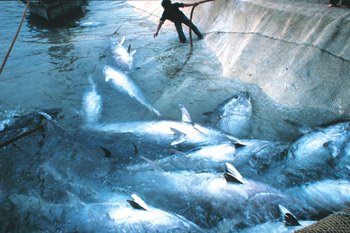ICCAT Bluefin Tuna Meeting 2006
by Rich Ruais
|
The International Commission for the Conservation of Atlantic Tunas (ICCAT) Plenary meeting held in Dubrovnik, Croatia from November 16 to November 26 was the largest and longest ICCAT meeting since at least 1991. There were 515 authorized delegates in attendance, representing 42 fishing nations (Actually, 66 including the collection of nations belonging to the European Community (EC).). The results for Atlantic bluefin tuna were not good for U.S. tuna fishermen with the EC stonewalling and refusing to adopt measures to implement clear scientific advice.
Dr. Rebecca Lent headed the U.S. delegation at the meeting, now that Dr. Bill Hogarth is the ICCAT Commissioner. Glenn Delaney and I represented the U.S. bluefin tuna and swordfish industries during the 11-day meeting. The results for the east and west are summarized below.
East Atlantic and Mediterranean Sea
All discussions over eastern Atlantic and Mediterranean bluefin were held in an atmosphere of ongoing or impending stock collapse as clearly identified in the 2006 stock assessment held last June. The latest scientific analysis by ICCAT’s Standing Committee on Research and Statistics (SCRS) showed that the current fishing mortality rate is three times what it should be in order to stabilize the stock. Thus, the scientific advice for the east is that catches need to be immediately reduced from the recent 50,000 metric ton (mt) level to no more than 15,000 mt; the spawning grounds need to be closed to directed fishing from May 1 to July 31; and the minimum size increased to 30 kg without tolerance. If all these measures were implemented, it would place the fishery fishing at FMSY levels and allow slow rebuilding.
|

At the ICCAT conference in Dubrovnik, Croatia, the U.S. was prepared to do serious battle over any challenge of the SCRS findings of impending eastern collapse and over the continuing damage to the western fishery stemming from the past decade of irresponsible non-management and gross overfishing in the east. The impact of the methods and intensity on tuna in the eastern end of the fishery has been high for a long time. This is a 1979 photo taken at Favignana, Sicily. Photo Courtesy of United Nations Food and Agriculture Organization |
|
|
|
|
Granite
by Mike Crowe
|
Everyone, it would seem, has stepped, tripped or driven over a granite curb, somewhere. Not everyone has stopped to think about what that curb was made of, why it looks the way it does or where it came from.
Curbstones may be the most common use for granite today. About every street in every city, suburb and urban stretches of the interstate highway system account for what must be many thousands of miles of curbstone. But enormous volumes of granite had other uses in the mid 1800’s, as the modern American city was evolving. Before steel and concrete, the solid, massive buildings of Boston, New York, Philadelphia, Washington and other cities, were built with granite. Many were public buildings—train stations, libraries, city halls, museums and banks—the monuments of the emerging U.S. economy. Granite was also used for wharfs and railroad and river bridges.
continue
|
| Gibran Buell, at the Sullivan quarry pounding a hole in granite. Heavy and big are two common images at a quarry. New cutting bits drill deep holes in minutes. A row of holes with wedges driven to tension each side of the row can break off truck size chunks. Photo: Fishermen's Voice |
|
|

